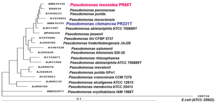Pseudomonas teessidea
| Pseudomonas teessidea | |
|---|---|
| Scientific classification | |
| Domain: | Bacteria |
| Phylum: | Proteobacteria |
| Class: | Gammaproteobacteria |
| Order: | Pseudomonadales |
| Family: | Pseudomonadaceae |
| Genus: | Pseudomonas |
| Species: | P. teessidea |
| Binomial name | |
| Pseudomonas teessidea | |
Pseudomonas teessidea[1] is a species of Pseudomonas bacteria which was first discovered in the North of England. The specific epithet teessidea was given by a microbiologist at Teesside University.[2] Biosurfactant from Pseudomonas teessidea : Surfactants work by reducing surface tension between two liquids or a liquid and a solid. Biosurfactants, surface-active agents of biological origin, have environment-friendly properties; they are bio-degradable, non-toxic and can be made organically using local raw material and producers. Biosurfactants can be used in soaps, detergents, medical ointments or as emulsifiers i.e. within ice cream, facial cream or sun lotion. Pseudomonas teessidea is a new bacterial species which was discovered by Dr. Pattanathu Rahman in the Northeast of England.[3] This bacterium has DNA coding distinct from existing species and has unique properties developed in response to the contaminated soil from which it comes. It produces rhamnolipids type of biosurfactants to detoxify oil and chemicals contaminants in the ground.[4]
Rhamnolipids are predominantly produced by the microbe Pseudomonas aeruginosa. However, Pseudomonas putida is a model organism with greater metabolic versatility and potential for industrial applications. Computational methods for metabolic engineering are able to model and optimise such biological models, leading to the improvement of a given biotechnological pipeline.The engineered genome-scale model of Pseudomonas putida built during a BBSRC Research project [5] can already be used to predict and maximise rhamnolipid production and transport through the cell membrane. The promising results found during this project have strengthened the collaboration between TeeGene and the Computational Biology group at Teesside University. The resulting pipeline will finally be used to build a genome-scale model of Pseudomonas teessidea for which a model is unavailable.[6] The resulting project will elucidate the metabolic engineering steps for overproduction of rhamnolipids and their transport out of the cell membrane.
Pseudomonas teessidea 16S rRNA PR6.5 (Type strain)
.jpg)
Biodiversity of Pseudomonas teessidea:
- UK: Biosurfactants and Bioemulsifiers[7]
- Sweden: There is great concern for the widespread increase of cyanobacterial blooms globally. Blooms can be toxin producers and cause serious health implications for wild life and humans. However, even blooms that are not toxin producers can be detrimental to the environment due to biomass increase, which can cause oxygen depletion that lead to fish death. From a productive lake (Ekoln, basin of lake Mälaren - Sweden) Monica Ricão Canelhas team managed to isolate cyano-lytic bacteria including Pseudomonas teessidea.[8]
- China: Effects of uranium on soil microbial biomass carbon, enzymes, plant biomass and microbial diversity in yellow soils[9]
- USA: Extended-Spectrum Beta-Lactamase Gene Sequences in Gram-Negative Saprophytes on Retail Organic and Nonorganic Spinach[10]
- France: Impact of lightning on evolution, structure and function of bacterial communities[11]
- India: BACTERIA FROM HIMALAYAN GLACIERS[12]
- Portugal: Estudo da actividade antimicrobiana de isolados provenientes de ambientes vulcânicos da Ilha Terceira - Açores - contra microrganismos indicadores relacionados com ambientes alimentares[13]
Phylogentic tree:

References
- ↑ Rahman, Pattanathu K. S. M.; Pasirayi, Godfrey; Auger, Vincent; Ali, Zulfiqur (2 February 2010). "Production of rhamnolipid biosurfactants by Pseudomonas aeruginosa DS10-129 in a microfluidic bioreactor". Biotechnology and Applied Biochemistry. 55 (1): 45–52. doi:10.1042/BA20090277. PMID 19958287.
- ↑ University, Teesside. "Teesside University - Science & Engineering research - Members". www.tees.ac.uk. Retrieved 25 May 2018.
- ↑ Rahman, P.K.S.M. (BBSRC Phyconet Conference). "Biosurfactants and Bioemulsifiers" (PDF). Retrieved 28 May 2018. Check date values in:
|date=(help) - ↑ (Elinor), Morgan, E.; (Bella), Adam, B.; (Alix), Collingwood-Swinburn, A.; (Pattanathu), Rahman, P. K. S. M. (2016-06-25). "Bioremediation of acid mine drainage and Biosurfactants from Pseudomonas teessidea".
- ↑ (Claudio), Angione, C.; (Pattanathu), Rahman, P. K. S. M. (2017-01-01). "Condition-specific engineering of Pseudomonas metabolism – Business Interaction Grant Case study".
- ↑ "CBMNet awarded ISCF Industrial Biotechnology Catalyst Early Stage Feasibility Projects | Crossing Biological Membranes". cbmnetnibb.group.shef.ac.uk. Retrieved 2018-05-28.
- ↑ "Biosurfactants and Bioemulsifiers" (PDF).
- ↑ Monica Ricão Canelhas. "The biocontrol potential of lytic bacteria against cyanobacterial blooms (2011)" (PDF). line feed character in
|title=at position 43 (help) - ↑ "Effects of uranium on soil microbial biomass carbon, enzymes, plant biomass and microbial diversity in yellow soils".
- ↑ "Extended-Spectrum Beta-Lactamase Gene Sequences in Gram-Negative Saprophytes on Retail Organic and Nonorganic Spinach" (PDF). line feed character in
|title=at position 65 (help) - ↑ "Impact of lightning on evolution, structure and function of bacterial communities".
- ↑ "BACTERIA FROM HIMALAYAN GLACIERS" (PDF).
- ↑ "Estudo da actividade antimicrobiana de isolados provenientes de ambientes vulcânicos da Ilha Terceira - Açores - contra microrganismos indicadores relacionados com ambientes alimentares" (PDF).